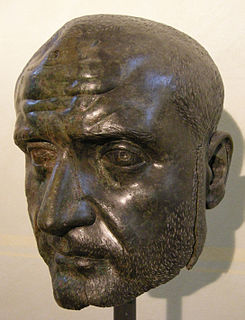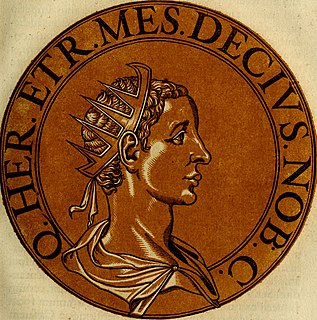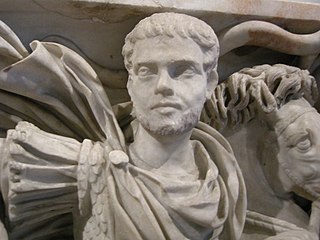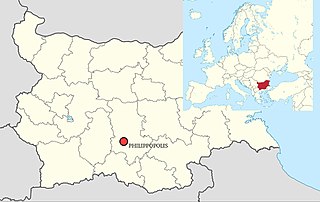
The Battle of Abritus, also known as the Battle of Forum Terebronii, occurred near Abritus in the Roman province of Moesia Inferior in the summer of 251 between the Roman Empire and a federation of Gothic and Scythian tribesmen under the Goth king Cniva. The Roman army of three legions was soundly defeated, and Roman emperors Decius and his son Herennius Etruscus were both killed in battle. They became the first Roman emperors to be killed by a foreign enemy. It was one of the worst defeats suffered by the Roman Empire against Germanics, rated by the Roman historian Ammianus Marcellinus as on par with the Battle of the Teutoburg Forest in AD 9, the Marcomannic invasion of Roman Italy in 170, and the Battle of Adrianople in 378.

The Battle of Adrianople, sometimes known as the Battle of Hadrianopolis, was fought between an Eastern Roman army led by the Eastern Roman Emperor Valens and Gothic rebels led by Fritigern. The battle took place in the vicinity of Adrianople, in the Roman province of Thracia. It ended with an overwhelming victory for the Goths and the death of Emperor Valens.

Marcus Julius Philippus, also known commonly by his nickname Philip the Arab, was Roman Emperor from February 244 to September 249. He was born in Arabia Petraea, the Roman province of Arabia, in a city situated in modern-day Syria. He went on to become a major figure in the Roman Empire. After the death of Gordian III in February 244, Philip, who had been Praetorian prefect, achieved power. He quickly negotiated peace with the Persian Sassanid Empire. During his reign, the city of Rome celebrated its millennium.

Trebonianus Gallus, also known as Gallus, was Roman Emperor from June 251 to August 253, in a joint rule with his son Volusianus.

Aemilianus, also known as Aemilian, was Roman Emperor for three months in 253.

Herennius Etruscus, was Roman emperor in 251, ruling jointly with his father Decius. He was born in c.227 AD. His father was proclaimed emperor by his troops in September 249 while in Pannonia and Moesia, in opposition to Emperor Philip the Arab. Decius defeated Philip in battle, and was also proclaimed emperor by the Roman Senate. Herennius Etruscus was elevated to caesar in 250, then further raised to augustus in May 251. When the Goths, under Cniva, invaded the Danubian provinces, Herennius Etruscus was sent with a vanguard, followed by the main body of Roman troops, led by Decius. They ambushed Cniva at the Battle of Nicopolis ad Istrum, routing him, before being ambushed and routed themselves at the Battle of Beroe. Herennius Etruscus was killed in the Battle of Abritus, alongside his father. After the deaths of both emperors, Trebonianus Gallus, who had been governor of Moesia, was elected emperor by the remaining Roman forces.

Hostilian was Roman emperor from July to November 251. Hostilian was born to Decius and Herennia Etruscilla at an unknown date and elevated to Caesar in May 251 by Decius, the same month as his older brother, Herennius Etruscus, was raised to co-emperor. After Decius and Herennius Etruscus were killed at the Battle of Abritus, an ambush by the Goths, Trebonianus Gallus was proclaimed emperor by the legions. Almost immediately, he elevated Hostilian to co-emperor and his son, Volusianus, to Caesar. Hostilian died in November 251, either due to plague or being murdered by Trebonianus Gallus.

Cniva was a Gothic chieftain who invaded the Roman Empire. He successfully captured the city of Philippopolis in 250 and killed Emperor Decius and his son Herennius Etruscus at the Battle of Abritus as he was attempting to leave the Empire in 251. This was the first time a Roman Emperor had been killed in combat against barbarians. He was allowed by the new Emperor Trebonianus Gallus to leave with his spoils and was paid tribute to stay out of the empire.

Volusianus, also known as Volusian, was a Roman Emperor from November 251 to August 253. His father, Trebonianus Gallus, became Roman Emperor after being elected in the field by the legion, following the deaths of the previous co-emperors Decius and Herennius Etruscus. Trebonianus Gallus raised Hostilian, the son of Decius, to augustus, making him his co-emperor in June 251. Volusianus was elevated to caesar in the same month. After the death, or murder, of Hostilian in November 251, Volusianus was raised to augustus, co-ruling with his father. The short reign of Trebonianus Gallus and Volusianus was notable for the outbreak of a plague, which is said by some to be the reason for Hostilian's death, the invasion of the Sasanian Empire, and the raids of the Goths. Volusianus was killed alongside his father in August 253 by their own soldiers, who were terrified of the forces of the usurper Aemilian which were marching towards Rome.
The Gothic Wars were a long series of conflicts against the Roman Empire between the years 249 and 554. The main wars are detailed below.

The Siege of Philippopolis was fought in about 250 between Rome and the Goths during the invasions of 249–253 at the Thracian city of Philippopolis, modern Plovdiv, Bulgaria. It was part of the long-running series of Gothic Wars.

Between about 376 and 382 the Gothic War against the Eastern Roman Empire, and in particular the Battle of Adrianople, is commonly seen as a major turning point in the history of the Roman Empire, the first of a series of events over the next century that would see the collapse of the Western Roman Empire, although its ultimate importance to the Empire's eventual fall is still debated.

Varazdat was a king of Arsacid Armenia from 374 until 378.
Valens was a Roman Emperor (364–378).
Socrates Chrestus was the second son of Nicomedes III of Bithynia. He usurped the Bithynian throne by deposing his elder brother or half brother, Nicomedes IV of Bithynia.
The Battle of Verona was fought between the Roman general and usurper Decius, and Roman Emperor Philip the Arab in 249. Decius was victorious, and Philip was killed. Decius then became Roman Emperor.
The gens Messia was a plebeian or family at Rome. The first person of this name to appear in history is Vettius Messius, a Volscian soldier whose courage inspired his comrades in a desperate battle against the Romans in 431 BC. It is not known when the Messii first obtained Roman citizenship, but members of the family appear in the lists of annual magistrates during the final decades of the Republic. In imperial times, some of the Messii achieved the highest offices of the Roman state.













